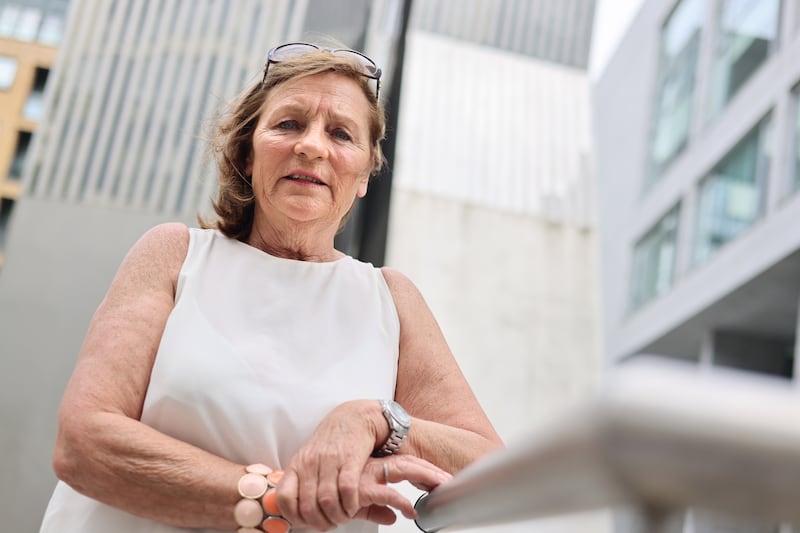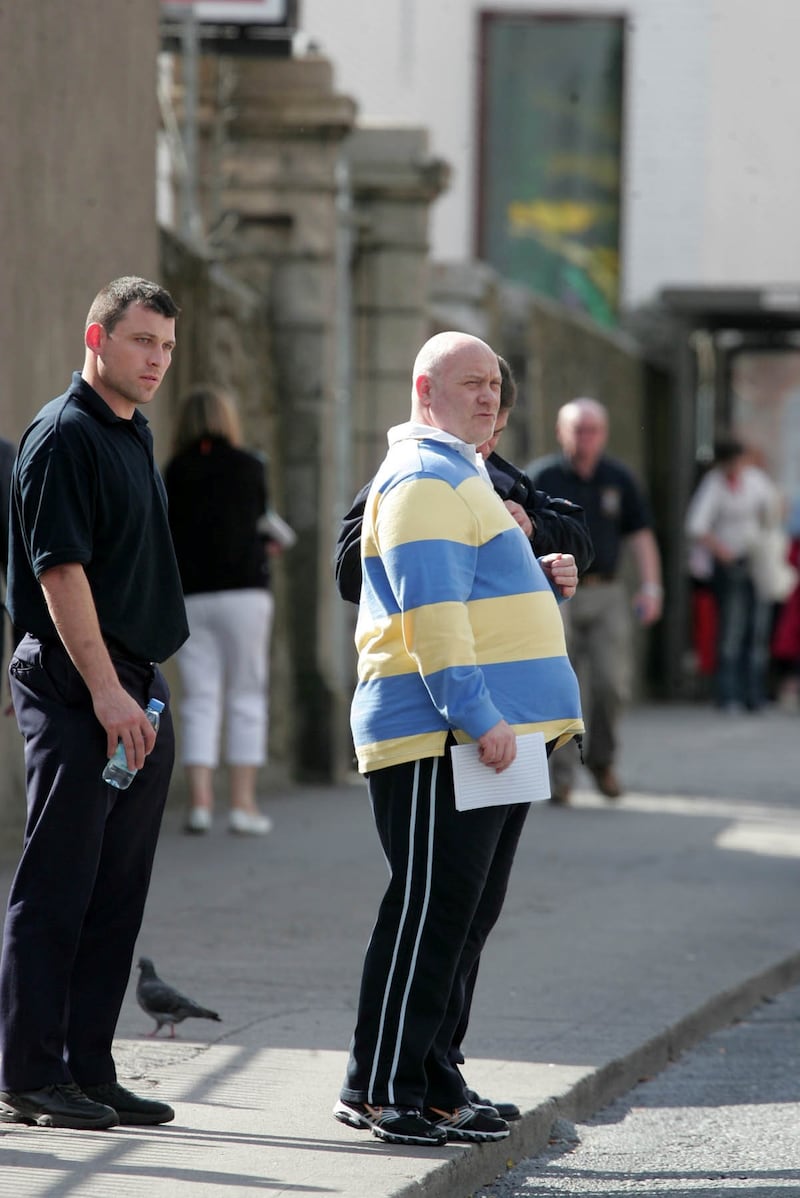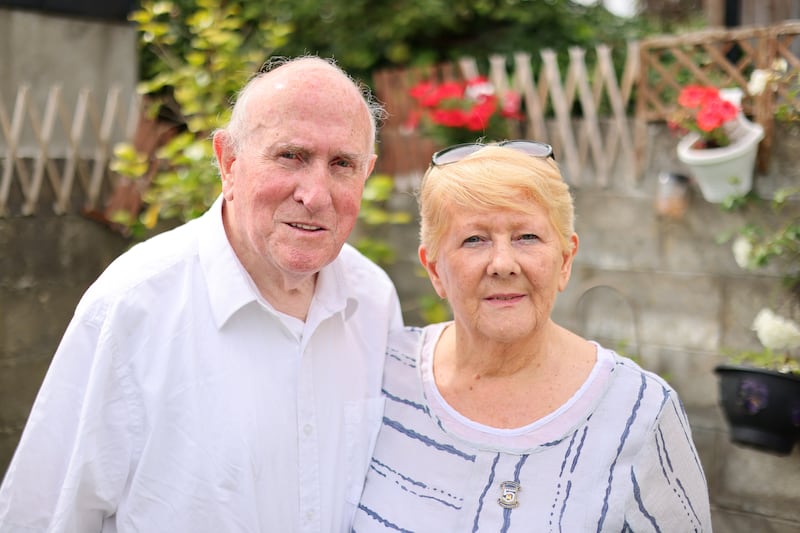The evening of October 27th, 1982, was a quiet one at Irish Army outpost 623 at As Sultaniyeh in Lebanon. Paul Clarke, an armoured car driver, had just taken a shower and was passing the radio station when he heard it crackle into life: “We’re hit up, we’re hit up.”
Trying to locate the position of the mayday, the radio operator had all Irish outposts check in. When he reached outpost 623 Alpha at Tibnin Bridge the message came again: “We’re hit up. Men down.” The panicked voice said there was blood everywhere and the attackers were still out there somewhere.
“I ran into the canteen and let out a roar: ‘Tibnin Bridge is hit up. I need a gunner outside now.’ I ran out into the first APC, I reversed it and bodies start to jump in,” Clarke recalls 40 years later.
He raced the vehicle down the hill towards the bridge, telling his gunner Dan O’Neill to test his guns by firing a few rounds into the dry riverbed on the way. When Clarke arrived he saw two bodies on the ground.
“The first body I got to was Peter Burke, who was dead. I move forward and the next body I got it was Tom Murphy, lying face down.” A short time later they found the body of Gary Morrow. He was also dead.
The only survivor at the outpost was 21-year-old Private Michael McAleavey. He was found inside the hut pointing his rifle out at two terrified Lebanese men who were stopped at the checkpoint. One soldier gently took McAleavey’s weapon and brought him outside, at which point he attacked the two men. He tried to take an Irish soldier’s weapon but was restrained and brought away.
A few hours later a terse message was relayed back to Army headquarters in Ireland: “One serious incident involving the killing by shooting of one NCO and two privates at Tibnin Bridge checkpoint at 1840 Zulu. Another soldier on duty at the checkpoint was uninjured but is suffering from severe shock. The area was cordoned off and an intense search is continuing.”
The following day, then taoiseach Charlie Haughey informed the Dáil that details were scarce but it appeared the soldiers had been “attacked by men armed with automatic weapons”. He asked deputies to join him in offering condolences to the family “and in wishing the surviving member of the checkpoint party a full and speedy recovery”.

Death at an Irish army checkpoint: Tibnin Bridge, part one
In a three-part podcast series Conor Gallagher and Sorcha Pollak tell the story of a massacre in Lebanon in 1982 and its aftermath.
Today, there is no mystery about what happened to Cpl Gary Morrow and privates Peter Burke and Thomas Murphy. All three were murdered by McAleavey when he opened fire on them with his automatic rifle before finishing them off with single shots to the head.
What remains unknown so many years later is why the young Belfast man, who had arrived in Lebanon just a week previously, committed such a heinous act against his comrades.
McAleavey came from a nationalist, west Belfast family. It was a tough upbringing; his mother went to England when he was young, leaving his father to raise the children.
He was a bright teenager but didn’t do great in school, McAleavey’s solicitor Joe Rice says. After leaving school he was approached by various paramilitary organisations but after a stint a toolmaker and a few other jobs, decided to enlist in the Irish Army in 1980, Rice says.
McAleavey didn’t settle in the Army and, according to his solicitor, was viewed suspiciously by others due to his west Belfast background. However, he completed various courses, including trying out the newly formed Army Ranger wing, before being selected for the Unifil mission in Lebanon.
Irish troops had been in Lebanon for four years at that stage and had already lost 16 men. Five months before McAleavey’s deployment, Israel had invaded Lebanon and the Irish contingent found themselves in the middle of widespread violence involving the Israeli and Lebanese militaries and various paramilitary groups.
Rice says McAleavey described feeling “drained and exhausted” when he was sent over and that he did not believe the United Nations should be there at all. Later court documents state McAleavey volunteered for overseas service to shorten his time in the Army.
He went out to Lebanon on October 20th, 1982, as part of the 52nd Infantry Battalion. A week later another soldier asked McAleavey to swap shifts, meaning he was sent out to Tibnin Bridge with Morrow, Murphy and Burke at 2pm to man the checkpoint there.
After the attack, medical personnel judged McAleavey to be in shock. He was taken to hospital and given sedatives before being released a short time later. But, despite his protests, he was not allowed to return to his unit. Army authorities were still unsure what had happened that night and McAleavey was at the very least an important witness who should be kept separate from the others. Rumours were already starting to spread about his role in the men’s deaths and there was some concern he might not be safe with his fellow soldiers from A Company.
The Army requested the help of An Garda Síochána, specifically the investigations section of Crime Branch, aka the murder squad
McAleavey was put into a sort of quasi-custody in a nearby military police facility known as Gallows Green. He was allowed exercise, to go to the shop and even, at one stage, attend a Christmas party but he was accompanied by military police (MPs) at all times. He repeatedly requested a transfer home and was repeatedly denied.
In various interviews with military investigators, McAleavey’s story remained the same. He said shortly after 8pm he had left his post to use the bathroom. As he was going into the toilet he heard machine gun fire and took cover until it stopped. He got up and ran before falling down a slope. After getting to his feet, he went to the guard room where he saw the bodies of Burke and Murphy.
A car arrived containing two locals. McAleavey ordered them out at gunpoint and waited for reinforcements to arrive.
As the days and weeks passed, Army authorities grew increasingly sceptical of McAleavey’s story. A huge search had uncovered no signs of an attack and, unusually, no group had claimed responsibility. None of nearby UN posts had reported any unusual activity.
UN forensic experts determined the men had been killed by rounds from an FN rifle, the same type of weapon carried by McAleavey, and that the fatal shots were delivered at very short range.

An unthinkable crime: Tibnin Bridge, part two
Among soldiers who have served in Lebanon, no incident is more notorious than the 1982 killings of Corporal Gregory Morrow, Private Peter Burke and Private Thomas Murphy at Tibnin Bridge, a checkpoint near the Israeli border.In today's episode, it's January 1983 and the investigation has stalled. Detective Tom Connolly and his colleagues fly out to Lebanon to help. Part two of three. Researched and reported by Conor Gallagher and Sorcha Pollak.Presented by Sorcha Pollak.Produced by Declan Conlon. Artwork by Paul Scott. Reconstruction voiced by Peter Heenan.
Getting McAleavey to admit his role was another matter. The Army requested the help of An Garda Síochána, specifically the investigations section of Crime Branch, aka the murder squad. The detectives were fresh from investigating the so-called Gubu murders of Malcolm Macarthur, but this was an entirely new challenge.
One of the detectives, Tom Connolly, recalls arriving in the airport in Beirut and being struck by the devastation caused by the war. “I remember looking up through a big hole in the roof and right underneath was a big pile of rubble. That put a shiver down your back.”
When the gardaí sat down to interview McAleavey a few days later, the soldier greeted them “with an extraordinary display of aggression”, Connolly recalls. “You’re no different than the f***ing MPs,” McAleavey told the gardaí.
But following multiple conversations and the offer of a cigarette, McAleavey “mellowed” somewhat. “Tell us the truth about what happened,” Det Chief Supt Dan Murphy said gently. There was a silence before McAleavey put his head in his hands and started to cry. “I shot them, I shot them,” he said.
McAleavey went on to explain that they had stopped a jeep containing two Israeli soldiers at the checkpoint. The Israelis refused to show their ID, and McAleavey called them “Jewboy” and then “yid” several times, before Cpl Morrow told them to drive on.
The corporal scolded McAleavey over his behaviour, leading to a row and a slagging match. McAleavey called Morrow a “stupid bastard” for not getting identification from the Israelis and Morrow threatened to put him on the next flight back to Ireland.
McAleavey had already told the MPs about the row, but this time he kept talking: “I started to walk away and as I did I cocked the weapon, turned around and opened up. I started spraying and just held my finger on the trigger.”
He continued: “I then remember running in beside them and mopping up. The last thing I remember was shooting Cpl Morrow ... I then realised what I had done and started to run.”
Connolly got McAleavey to sketch out where he was when he killed the men. “Maybe his conscience got to him or whatever, I don’t know,” says Connolly on the question of why the soldier suddenly confessed. That happens sometimes with murder suspects, he says.
All that was left was for McAleavey to be charged by the MPs and transported back to Ireland. As the crime had occurred while he was on active duty, McAleavey would be prosecuted through the military justice system and kept in military detention.
This presented its own problems. The military justice system was more used to dealing with offences such as going absent without leave or thefts from stores. It occasionally had to deal with more serious offences but murder was unheard of, never mind three murders. One of the main problems for the Army was keeping the accused safe until his court martial.
Clarke recalls McAleavey was first brought to Cathal Brugha barracks. At one point there were rumours that metal shavings were being put in McAleavey’s food, Clarke says. “He wasn’t safe at all.” While in custody, McAleavey went on a hunger and thirst strike without explanation before abandoning it after a week.
The court martial began in the Curragh Army camp on July 18th and McAleavey entered a not guilty plea. General courts martial differ from civilian trials in several ways, most notably the jury is made up of seven officers rather than 12 civilians. The accused is still subject to military regulations, meaning McAleavey was marched in every day in uniform and required to sit bolt upright throughout proceedings.

Gary Morrow’s wife, Colette, had just given birth to their child four days before the trial. She had found out she was pregnant on the morning her husband was buried. After the birth the maternity hospital would not discharge her so she left the hospital every morning to attend the court martial and returned every night.
“When I went into the courts for the first time I didn’t look up, I didn’t look around, I didn’t want to see him,” she recalls. She remembers starting to shake when McAleavey was marched in.
McAleavey’s earlier confession left him with limited options at trial. He was represented by perhaps the country’s best-known barrister, Paddy McEntee, who tried, at the behest of his client, to have the evidence of the confession excluded.
McEntee said his client had confessed only out of desperation to get home. He said he was being held in oppressive conditions in Lebanon where no one, not even the MPs, would talk to him. By the time the gardaí arrived he was extremely vulnerable psychologically and would have said anything to get back to Ireland, he contended.
It did not work. The confessions were ruled admissible, rendering the rest of the trial almost a formality. After three months, still the longest court martial in State history, the panel of officers returned guilty verdicts on all three counts. McAleavey was sentenced to “penal servitude for life” and dishonourably discharged from the Army.
Now no longer a soldier, McAleavey was transferred into civilian custody and imprisoned in Mountjoy. The case faded from the headlines and McAleavey settled into prison life, becoming, according to one official report, “a model prisoner”.

He was such a good inmate that in 1993, just a decade after the trial, he was admitted into a pre-release scheme which would have seen him granted full release by 1998, having served a 15-year term. However, he was removed from the programme in 1997 after failing a drug test, records show.
McAleavey spent some of his sentence in Portlaoise, the State’s high-security prison, which is guarded at all times by the Army. Clarke remembers being in charge of the guard detail on the roof when he was brought in. “It wasn’t a good feeling at all,” he recalls. “All you want to do is take him out. A lot of people wanted to do that. But if you done that you’re worse than he is. You just get on with it.”
McAleavey’s lawyers repeatedly lobbied the government to get him transferred to a Northern Irish prison so he could be close to his family. Eventually, despite protests from soldiers’ groups and peacekeeping veterans, the government conceded. He was transferred to Maghaberry Prison in 2007 and released three years later, having served 27 years and one month behind bars. He married a French woman and moved to southern France sometime later. He remains there today.
That brings us back to the question of why a 21-year-old soldier gunned down three of his colleagues in cold blood after a seemingly minor argument. It was a question posed by Mr Justice Brian Kerr in 2008 when he was deciding how long McAleavey should remain in prison in Northern Ireland.
McAleavey’s lawyers told the judge he had been suffering from dehydration, sleep deprivation, dissociation and lack of nourishment before the shooting, all of which contributed to a high level of stress. Furthermore, his lawyers contended, McAleavey’s training had “predisposed him to the use of lethal weapons”.
The arguments found little favour with the judge, who observed no supporting evidence had been produced. Surely McAleavey’s training would mean he was more likely to use restraint with a deadly weapon, the judge said.
“If, as seems likely, the immediate catalyst was a dispute between the prisoner and one of the other members of the unit, one is at a loss to understand why all three were killed,” Mr Justice Kerr observed.
He also expressed doubt about McAleavey’s repeated statements of remorse, saying his reluctance to offer an explanation for the murders was “irreconcilable” with genuine repentance.

Face to face with a killer: Tibnin Bridge, part three
The families of Corporal Morrow, Private Burke and Private Murphy watch on as Ireland's best criminal defence barrister tries to get Michael McAleavy acquitted at his court martial for murder in 1983. Part three of three.Researched and reported by Conor Gallagher and Sorcha Pollak.Presented by Sorcha Pollak.Produced by Declan Conlon. Artwork by Paul Scott. Reconstruction voiced by Peter Heenan.
Through a family member, McAleavey declined to speak to The Irish Times but his solicitor Joe Rice agreed to an interview. “He couldn’t really explain it in simple words ... It seemed to me that he had just had a complete mental breakdown on this particular day,” Rice says when asked about McAleavey’s motive.
“He gave me reasons. And they seemed to me to be sustainable reasons. Maybe not sustainable back in the 1980s but with the advances in psychiatry and psychology, I think it would have been a different trial if it was held today.”
Some of the people interviewed said McAleavey had far-right or neo-Nazi sympathies. An Irish Times article following his conviction cited teachers and former pupils saying he handed out leaflets for the now dissolved National Socialist Irish Workers Party as a teenager and put swastika stickers around his school. The first thing he did when he arrived in Lebanon was paint over a star of David at the camp, the same article stated.
“Absolutely not,” says Rice when asked about these allegations. “Nothing could have been further from the truth in my experience. And in medical reports from the time nothing like this was picked up.”
“He was strange,” says Colette Morrow. She recalled being on the train with her husband sitting across from McAleavey just before they deployed. “I tried to make conversation with him and he would just stare at me and his eyes would go huge,” she said. When he continued staring, Colette realised he was sketching her face in a newspaper. She gives a simple answer when asked why she thinks McAleavey murdered her husband: “He just didn’t like taking orders.”
Clarke who sometimes played squash with McAleavey before deployment, said he should never have been sent to Lebanon. “The guy wasn’t right.”
He recalls the shame and anger felt in the Army, and in his unit, for years after the shootings. Soldiers from other units referred to the 52nd as MurderBatt, something which led to more than a few punch-ups over the years, he says.
“He disgraced himself, his unit, the Defence Forces and the standing of Ireland as peacekeepers at the time.” Soldiers dying in battle is tragic but understandable, Clarke says, “because that’s what we’re trained for. But outside that, that’s murder, cold-blooded, heartless murder.”

Whatever effect the murders had on the Army, they had a far greater effect on the three men’s families. Mary Burke, mother of Peter, wears a medal of the 5th Battalion, her son’s home unit, wherever she goes.
“Our table was full of laughter every Sunday and that’s what we miss,” she says as she sits in her livingroom with her husband Noel. Reminders of Peter are everywhere on the walls of their Inchicore home, including a portrait they had painted of him after he died. “I don’t think a day ever goes by that Peter’s not mentioned.”
Mary and Noel remain angry that McAleavey was considered for early release after just a decade. In their view, he should still be in prison. “Life should mean life,” Noel says.
As we leave, Mary gives us a Mass card, the same one she has handed into McAleavey’s court hearings over the years. Below a photograph of Peter Burke there is a message: “Blessed are the peacemakers.”











